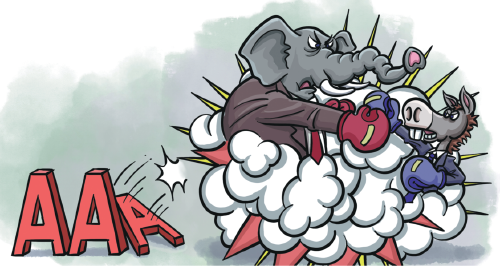US loss of credit rating a wake-up call

JIN DING/CHINA DAILY
The downgrade by Fitch Ratings of the United States' sovereign credit rating from AAA to AA+ on Aug 1 should not come as a surprise to the world, as the credit rating was already under a negative watch from May.
Following the latest downgrade and a similar move by Standard and Poor's in 2011, only Moody's maintains a triple-A assessment of the US Treasuries. Fitch quoted three key reasons for downgrading the US' sovereign credit rating. The first is the expectation that the US fiscal position will continue to deteriorate over the next three years. The second is a high and growing general government debt burden. And the third is the erosion of governance, particularly given repeated threats of breaching the debt limits and last-minute resolutions.
Debt-to-GDP ratio much higher than AAA median
Fitch expects the US general government deficit to increase from 3.7 percent in 2022 to 6.3 percent of GDP in 2023 and 6.9 percent in 2025. The interest-to-revenue ratio, according to Fitch, is likely to reach 10 percent by 2025. And the debt-to-GDP ratio is projected to reach 118.4 percent by 2025, two-and-a-half times higher than the "AAA" median of 39.3 percent.
The downgrade set off a mild weakening tone across financial markets. US Treasury yields rose slightly higher, especially in the 10-30 years part of the curve, and US stock markets fell following the announcement. The US dollar index was a touch stronger, in line with the risk aversion seen across markets.
That being said, other market factors such as stronger-than-expected private payroll data, a higher-than-expected treasury issuance target for the quarter, and the US' equity earnings data also impacted market price action in the days immediately following the downgrade.
The relatively mild market reaction, especially compared with the volatile price action following S&P's downgrade of the US sovereign credit rating in 2011, could be attributed to some factors.
First, the US economy is on a much stronger footing now compared with 2011. Twelve years ago, the US' debt ceiling crisis occurred amid a slowly recovering economy with a high unemployment rate of 9 percent. Current data show a resilient US labor market and consumer and business sentiment, despite sharply higher interest rates.
Second, a higher risk premium may already be priced into Treasury markets following the multiple episodes of close-call US debt negotiations, including one earlier this year.
And third, investor demand remains largely intact, given the US Treasury's position as the deepest, most liquid fixed-income market.
Despite the resilience of the financial markets to the Fitch decision to downgrade the US' sovereign credit rating, it is still conceivable that government borrowing costs will increase alongside a weaker dollar. The initial reaction to higher yields could have increased demand for US Treasuries and the dollar. But interest rate parity suggests that a weaker currency could materialize in the medium term.
Downgrade highlights some longer-term issues
While the initial market reaction has been muted, the downgrade does raise questions about the long-term sustainability of US government debt amid a rising debt burden and a lack of credible solutions or consensus to address the problem. Projections by the US Congressional Budget Office suggest that the US' federal deficits will continue to rise, driven by higher primary deficits (higher outlays for social security and health expenditure) as well as higher net interest outlays as a percentage of GDP.
At the same time, gross government debt is unsustainable across several advanced economies, resulting in a fast-shrinking universe of high-credit sovereign debts. Economies with the highest credit rating at S&P Global Ratings, Fitch and Moody's Investors Service include Germany, Denmark, Netherlands, Sweden, Norway, Switzerland, Luxembourg, Singapore and Australia.
Most advanced markets in North America and Europe have resorted to generous fiscal support to help corporations and households weather the COVID-19 pandemic.
Another takeaway is the increasing importance of fiscal governance in credit ratings. Also, Fitch made the decision based on the repeated threat of a government shutdown. By considering the political process of budgetary management, Fitch has signalled that sensible bipartisan cooperation is as important as economic fundamentals.
While higher inflation does reduce the real value of the existing debt, higher interest rates on new borrowing could also mean an elevated interest burden in the future.
Rising debt servicing costs would also divert investment from other vital areas, such as infrastructure, education and building resilience against climate change. The hypothesis that fiscal spending will boost growth enough to increase revenues, thus improving debt sustainability, is yet to be proven.
Another risk is the erosion of investor confidence. Global reserve managers have gradually diversified their reserves as a risk mitigation measure. Apart from increasing debt supply as a result of persistent fiscal deficits and the removal of quantitative easing measures reducing demand, Treasury borrowing costs could be impacted over the longer term.
The Fitch downgrade has highlighted some of the longer-term issues of the US' fiscal deterioration, a large and growing government debt burden, and the erosion of governance over peers, given repeated debt limit standoffs and risky last-minute resolutions on potential defaults. While the market may have priced in these risks to some extent in the near term, the questions about longer-term debt sustainability remain.
There is also a longer-term issue about risk-free investment. Some lingering questions will surface if the US loses the triple-A rating by other agencies. The question is: Would other AAA-rated sovereign debts be able to replace the US Treasury as the benchmark for risk-free assets?
Clarence Wong is chief economist at Peak Reinsurance Company; and Kritika Kashyap is an economist at the same company. The views don't necessarily reflect those of China Daily.
Photos
Related Stories
- American soldier crossing border into DPRK disillusioned with American society: KCNA
- Death toll from Hawaii wildfires up to 106
- Death toll from Hawaii wildfires up to 101, says governor
- Fitch warns it may have to downgrade dozens of U.S. banks
- U.S. Hawaii residents fear losing Lahaina as wildfire makes housing crisis worse: Washington Post
- Mob steals 300,000 USD worth of items in Los Angeles mall
- It is US that is a ticking time bomb for the global economy, not China
- U.S. still focused on diplomatic solution to attempted coup in Niger: Blinken
- Death toll from Hawaii wildfires rises to 99
- Hawaii residents reel from deadly wildfires as authorities drag feet in relief
Copyright © 2023 People's Daily Online. All Rights Reserved.









